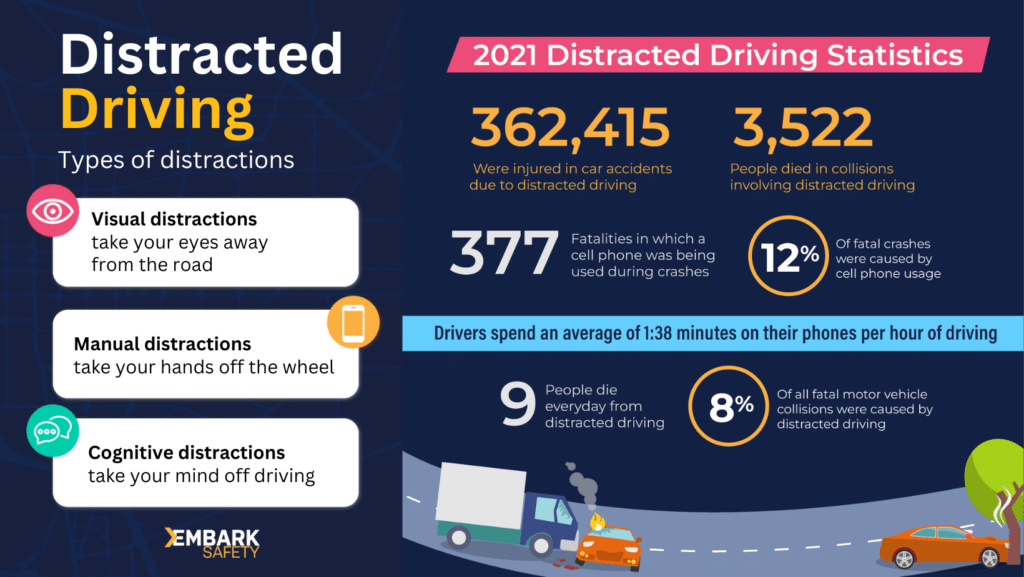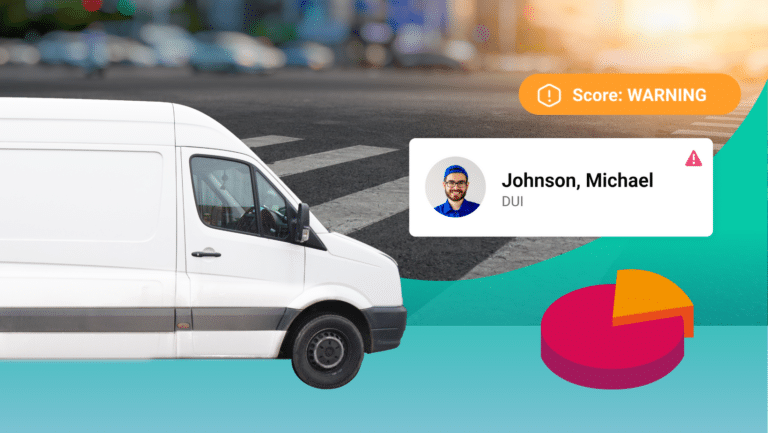How to Spot Fleet Distracted Driving Trends

April is Distracted Driving Awareness Month. Distracted driving is responsible for 11% of motor vehicle crashes yearly in the United States.
Distracted driving has become a significant concern for fleet and safety managers. With more smartphones, in-car tech, and other distractions, ensuring the safety of drivers and other road users is more critical than ever.
In this blog, we’ll look at common driving distractions among fleets, signs to identify risky driving trends, and ways to take proactive steps to reduce risks.
3 Types Of Distracted Driving
Distracted driving refers to any activity that diverts a person’s attention away from driving a vehicle. The three most common types of distracted driving are visual, manual, and cognitive distractions.
- Visual distractions occur when drivers take their eyes off the road, such as looking at a phone or GPS.
- Manual distractions involve taking hands off the wheel, like texting or adjusting the radio.
- Cognitive distractions occur when a driver’s mind is not focused on driving, like daydreaming or being preoccupied with personal issues.
While various types of distractions exist, phone usage is one of the most critical. Phone usage involves all three forms of distraction: visual, manual, and cognitive. When drivers use their phones, they look away from the road, take their hands off the wheel, and stop focusing on driving to text, call, or browse the internet.
Among newer generations of drivers, phone usage is deeply ingrained. According to a survey by AT&T, 83% of millennials acknowledge reading text messages while driving, while 71% admit to composing or sending texts while behind the wheel. Moreover, it’s increasingly common to see drivers record videos, go live, or take selfies while on the road.

Data taken from National Highway Center Administration. Click the infographic to enlarge.
Signs of Distracted Driving In Your Fleet
Detecting signs of distracted driving within your fleet is crucial for upholding safety and compliance standards. Keep an eye out for the following indicators:
Erratic Driving Behavior
Noticing erratic driving behaviors in your fleet drivers is a significant clue that they may be distracted. Look out for unexpected actions such as rapid lane changes, abrupt braking, or drifting from their designated lane.
Dashcam footage or eyewitness reports can provide valuable evidence of erratic driving behavior. Reviewing this footage can help identify instances of distraction. Read more: Top Fleet Management Technologies To Improve Driver Behavior.
Frequent MVR Violations
Reviewing Motor Vehicle Records (MVRs) regularly can provide insights into your drivers’ behavior behind the wheel. If drivers are accumulating violations and citations for speeding, running red lights, or other traffic offenses, it could indicate they are distracted on the road. Read more: Major vs Minor Traffic Violations.
Pay close attention to the types of violations recorded on MVRs and identify any recurring patterns among drivers. This could indicate areas where additional training or intervention may be necessary to address distracted driving behaviors effectively.
Increased Accident Rate
A sudden rise in accidents or near-misses involving your fleet vehicles can be a red flag for distracted driving. These incidents may include rear-end collisions, sideswipes, or even more severe accidents resulting from drivers’ failure to react promptly to hazards on the road.
Analyzing accident reports and incident data can help identify trends and patterns that indicate distracted driving. Look for common factors such as driver inattention, failure to yield the right of way, or failure to maintain a safe following distance.
In 2021, a Florida jury awarded a landmark $1 billion dollar verdict in a wrongful death trucking case. The jury placed blame on two trucking companies, Kahkashan Transportation Inc. and AJD Business Services Inc. The driver from AJD, was on his cell phone, driving over the legal limit of hours, and without a Commercial Driver’s License when he caused the accident.
Read more: Nuclear Verdicts: How To Reduce Exposure?
Addressing Fleet Distracted Driving Issues
Addressing distracted driving requires a proactive approach involving education, technology, policy enforcement, and fostering a safety culture within your organization.
Reinforce safety with education and training
Start by educating drivers about the dangers of distracted driving and its impact on their safety and the safety of others on the road. This education should cover various forms of distractions, including using electronic devices, eating, grooming, or engaging in conversations while driving. Providing real-life examples, statistics, and case studies can help drivers understand the seriousness of the issue. Read more: 5 Safety Messages For Drivers To Reduce Accidents.
Implement training programs that focus on safe driving practices and techniques for minimizing distractions. Include modules on effective time management, prioritizing tasks, and managing workload to reduce the temptation to multitask while driving.
Develop clear safety policies
Develop clear policies and guidelines regarding distracted driving and ensure that all drivers know and comply with these policies. Define what constitutes distracted driving, specify prohibited activities, and outline consequences for violations.
Invest in safety technology
Invest in technology solutions that can help mitigate distractions and enhance safety. This could include hands-free communication systems, distraction-monitoring software, or telematics devices that provide real-time feedback on driver behavior. Consider utilizing MVR monitoring technology to track drivers’ records in near real-time to promptly detect any new violations, including those related to distracted driving.
Organizations can create a lasting impact on reducing distracted driving incidents through consistent enforcement of policies, regular training updates, and fostering an environment where safety is non-negotiable.
Need help managing driver safety? Contact us today to learn more about how our MVR Monitoring technology can help you detect distracted driving and easily provide a way to send targeted training to employees when they need it. One of our most common trainings is “Distracted Driving- The Decisions You Make.” See all fleet driver lessons.
*We are not lawyers. Consult with your legal counsel to ensure your processes and procedures meet/ or exceed safety standards and compliance regulations. Please read our legal disclaimer.






